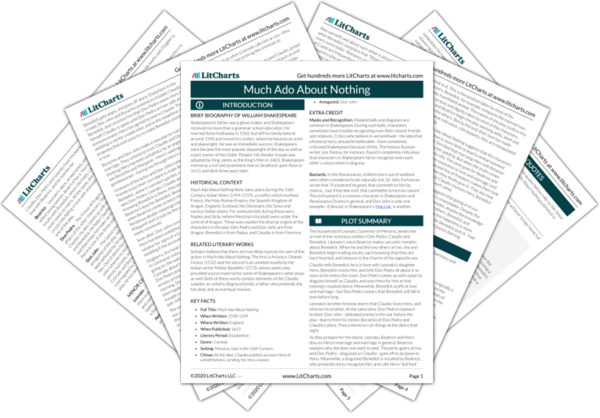Welcome to the LitCharts study guide on William Shakespeare's Much Ado About Nothing. Created by the original team behind SparkNotes, LitCharts are the world's best literature guides.
Much Ado About Nothing: Introduction
Much Ado About Nothing: Plot Summary
Much Ado About Nothing: Detailed Summary & Analysis
Much Ado About Nothing: Themes
Much Ado About Nothing: Quotes
Much Ado About Nothing: Characters
Much Ado About Nothing: Symbols
Much Ado About Nothing: Literary Devices
Much Ado About Nothing: Quizzes
Much Ado About Nothing: Theme Wheel
Brief Biography of William Shakespeare

Historical Context of Much Ado About Nothing
Other Books Related to Much Ado About Nothing
- Full Title: Much Ado About Nothing
- When Written: 1598-1599
- Where Written: England
- When Published: 1623
- Literary Period: Elizabethan
- Genre: Comedy
- Setting: Messina, Italy in the 16th Century
- Climax: At the altar, Claudio publicly accuses Hero of unfaithfulness, sending her into a swoon.
- Antagonist: Don John
Extra Credit for Much Ado About Nothing
Masks and Recognition. Masked balls and disguises are common in Shakespeare. During such balls, characters sometimes have trouble recognizing even their closest friends and relatives. Critics who believe in verisimilitude—the idea that a fictional story should be believable—have sometimes criticized Shakespeare because of this. The famous Russian writer Leo Tolstoy, for instance, found it completely ridiculous that characters in Shakespeare fail to recognize even each other’s voices when in disguise.
Bastards. In the Renaissance, children born out of wedlock were often considered to be naturally evil. Sir John Fortescue wrote that “If a bastard be good, that commeth to him by chance… but if hee bee evill, that commethe to hym by nature.” The evil bastard is a common character in Shakespeare and Renaissance Drama in general, and Don John is only one example—Edmund, in Shakespeare’s King Lear, is another.







